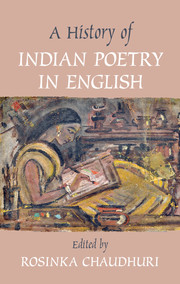Book contents
- Frontmatter
- Contents
- Contributors
- Acknowledgments
- Introduction
- SECTION I THE BROAD NINETEENTH CENTURY: INDIANS IN ENGLISH AND THE ENGLISH IN INDIA
- 1 The First Indian Poet in English: Henry Louis Vivian Derozio
- 2 English Poetry in India: The Early Years
- 3 From Albion's Exile to India's Prodigal Son: The English Poetry of Michael Madhusudan Datta (1824–1873)
- 4 Transforming Late Romanticism, Transforming Home: Women Poets in Colonial India
- 5 The Locations and Dislocations of Toru and Aru Dutt
- 6 Poetry of the Everyday: Comic Verse in the Nineteenth Century
- 7 Toru Dutt and “An Eurasian Poet”
- 8 Rabindranath Translated to Tagore: Gitanjali Song Offerings (1912)
- SECTION II PUBLISHERS, PUBLISHING HOUSES, AND THE PERIODICAL PRESS
- SECTION III POETRY: 1950–2000
- SECTION IV POETS OF THE DIASPORA
- SECTION V THE NEW MILLENNIUM POETS ON THEMSELVES
- Bibliography
- Index
7 - Toru Dutt and “An Eurasian Poet”
from SECTION I - THE BROAD NINETEENTH CENTURY: INDIANS IN ENGLISH AND THE ENGLISH IN INDIA
Published online by Cambridge University Press: 05 March 2016
- Frontmatter
- Contents
- Contributors
- Acknowledgments
- Introduction
- SECTION I THE BROAD NINETEENTH CENTURY: INDIANS IN ENGLISH AND THE ENGLISH IN INDIA
- 1 The First Indian Poet in English: Henry Louis Vivian Derozio
- 2 English Poetry in India: The Early Years
- 3 From Albion's Exile to India's Prodigal Son: The English Poetry of Michael Madhusudan Datta (1824–1873)
- 4 Transforming Late Romanticism, Transforming Home: Women Poets in Colonial India
- 5 The Locations and Dislocations of Toru and Aru Dutt
- 6 Poetry of the Everyday: Comic Verse in the Nineteenth Century
- 7 Toru Dutt and “An Eurasian Poet”
- 8 Rabindranath Translated to Tagore: Gitanjali Song Offerings (1912)
- SECTION II PUBLISHERS, PUBLISHING HOUSES, AND THE PERIODICAL PRESS
- SECTION III POETRY: 1950–2000
- SECTION IV POETS OF THE DIASPORA
- SECTION V THE NEW MILLENNIUM POETS ON THEMSELVES
- Bibliography
- Index
Summary
Henry Derozio, Toru Dutt, Aurobindo Ghose, and Sarojini Naidu were courageous and perhaps charming men and woman, but not those with whom you could today do business.
What follows is an atonement for what is said above.
In December 1874 there appeared in Bengal Magazine a short essay, “An Eurasian Poet,” by Toru Dutt. As an early example of an Indian poet in English commenting on another poet, and the only piece of criticism we have by her, it is a literary document of obvious importance. It is also the beginning of a tradition of Indian poets writing on other poets, though one that has surfaced only fitfully. For self-absorbed Indian novelists, the tradition of writing on other novelists may not have surfaced at all. A literary document carries with it the historical moment in which it is written. It is this moment, and this hitherto unexamined document, “An Eurasian Poet,” that I propose to read closely, while also dwelling on the poetic tradition that its two opening paragraphs refer to.
The essay begins, “Ah – it's the hackneyed subject of Derozio with the innumerable Christian names again – exclaims the reader glancing at my title.” And glancing at the title, so the reader could well have exclaimed. Even 140 years after it was published, readers are exclaiming the same thing, with one difference. While the Bengal Magazine readers would have turned to page 189 and learned the truth about the Eurasian's identity in 1874, Dutt scholars, and especially Derozio scholars, have only made references to the essay, followed by some wrong assumptions. Ironically, since Henry Louis Vivian Derozio was a Eurasian or East Indian, the contemporary terms for a person of mixed race, they have invariably presumed, “glancing at [the] title,” that by Eurasian she meant him.
- Type
- Chapter
- Information
- A History of Indian Poetry in English , pp. 114 - 129Publisher: Cambridge University PressPrint publication year: 2016
- 2
- Cited by



